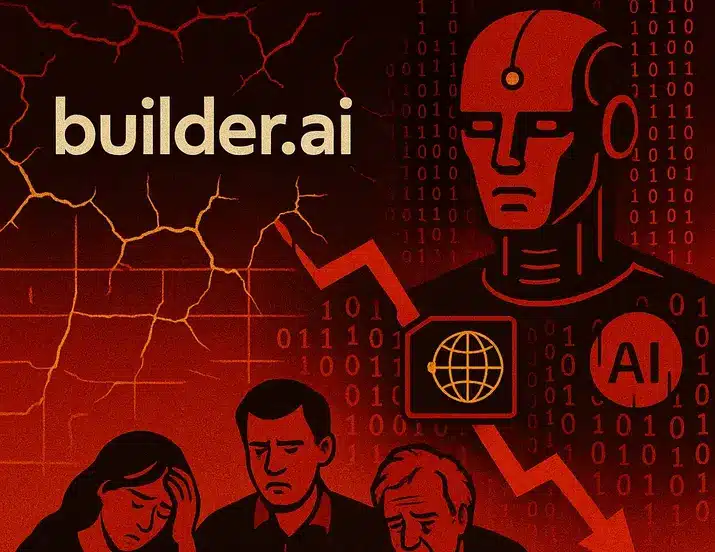Introduction: The Builder.ai Fraud Uncovered
The Builder.ai fraud represents one of the most audacious tech startup scams in recent history. This Builder.ai fraud managed to deceive some of the world’s most sophisticated investors, including Microsoft, SoftBank, and Qatar’s sovereign wealth fund, into believing they were backing a revolutionary AI-powered app development platform. The Builder.ai fraud ultimately resulted in a $1.5 billion valuation based entirely on smoke and mirrors.
The Builder.ai fraud began in 2016 when founder Sachin Dev Dugal launched Engineer.ai (later rebranded to Builder.ai) with promises of democratizing software development through artificial intelligence. The Builder.ai fraud claimed that their platform could build custom apps with 80% automation using AI, making app development as simple as ordering a pizza. However, the reality behind the Builder.ai fraud was far more sinister.
Understanding the Builder.ai Fraud
The Origins of the Builder.ai Fraud
The Builder.ai fraud started with a simple but compelling pitch: democratize software development by making it accessible to non-technical entrepreneurs. The Builder.ai fraud promised to use revolutionary AI technology to automate 80% of the app development process, with human oversight handling the remaining 20%. This Builder.ai fraud positioned itself as the solution for small businesses that couldn’t afford expensive development teams.
The Builder.ai fraud was masterminded by Sachin Dev Dugal, who understood that the key to attracting investors wasn’t building a legitimate product, but rather creating an irresistible narrative. The Builder.ai fraud used simple analogies like “ordering a pizza” to make complex software development seem accessible to potential customers who didn’t understand the technical realities.
The AI Hype and the Builder.ai Fraud
The Builder.ai fraud capitalized on the growing AI hype that was sweeping through Silicon Valley. The Builder.ai fraud understood that adding “AI” to a company name had become a “cheat code” for attracting investment, similar to how adding “.com” to company names worked during the dot-com bubble. The Builder.ai fraud exploited this trend by claiming to use cutting-edge artificial intelligence when the reality was far different.
The Builder.ai fraud claimed that their platform featured an AI assistant named Natasha that could understand customer requirements and automatically assemble apps using reusable code components. The Builder.ai fraud promised that this AI system would handle the majority of development work, with human specialists only needed for final customization. This Builder.ai fraud narrative was designed to appeal to investors looking for the next big AI breakthrough.
The Investment Deception of the Builder.ai Fraud
SoftBank and the Builder.ai Fraud
The Builder.ai fraud achieved its first major breakthrough when it secured a $29.5 million Series A investment from SoftBank in 2018. The Builder.ai fraud targeted SoftBank specifically because of the company’s reputation for making investment decisions based on gut feelings rather than thorough due diligence. The Builder.ai fraud understood that SoftBank founder Masayoshi Son was particularly interested in AI-related projects and was willing to take significant risks on futuristic technology.
The Builder.ai fraud presented itself as exactly the type of high-risk, high-reward investment that SoftBank was known for backing. The Builder.ai fraud claimed to have bootstrapped to $24 million in revenue and projected crossing the $100 million revenue mark by 2020. The Builder.ai fraud also boasted partnerships with major companies like the BBC, Virgin Group, and the San Francisco Giants, creating an image of legitimacy and success.
The Growth Deception in the Builder.ai Fraud
The Builder.ai fraud understood that venture capital valuations are based on growth potential rather than current profitability. The Builder.ai fraud focused on demonstrating rapid month-over-month and year-over-year growth to justify increasingly higher valuations. The Builder.ai fraud claimed to have 32,000 engineers in their network in 2018, which allegedly grew to 75,000 by 2019.
The Builder.ai fraud used these inflated numbers to create the illusion of massive scale and capability. However, these claims raised red flags among industry experts who questioned why a company claiming 80% AI automation would need such a large human workforce. The Builder.ai fraud ignored these concerns and continued to pursue aggressive growth metrics to attract additional investment.
Hiring for Trustworthy AI and Tech Talent?
Post jobs in AI research, software development, and tech compliance—find professionals who can prevent frauds like Builder.ai and build responsible innovation.
Post a Job Now →The Reality Behind the Builder.ai Fraud
The Human Labor Behind the Builder.ai Fraud
The Builder.ai fraud was eventually exposed when investigations revealed that the company’s “AI-powered” platform was actually powered by hundreds of underpaid engineers in India, Vietnam, Romania, Ukraine, and Poland. The Builder.ai fraud had been outsourcing development work to these engineers while claiming that artificial intelligence was doing the majority of the work.
The Builder.ai fraud used a company called Versie to manage these outsourced engineers, who worked tirelessly to fulfill customer requests that were supposedly being handled by AI. The Builder.ai fraud did use some AI tools to assist with development, but the level of automation was nowhere near the 80% that had been promised to investors and customers.
The Financial Fraud Within the Builder.ai Fraud
The Builder.ai fraud extended beyond false claims about AI capabilities to include serious financial misconduct. The Builder.ai fraud allegedly inflated its revenue by 300% using a round-trip billing scheme that created fake transactions to artificially boost reported earnings. The Builder.ai fraud used small upfront deposits, undisclosed discounts, and circular transactions through third-party intermediaries to create the appearance of legitimate business activity.
The Builder.ai fraud claimed $220 million in revenue for 2024 when the actual income was closer to $50 million. This Builder.ai fraud financial deception was designed to maintain the company’s valuation and attract additional investment from major players like Microsoft and Qatar’s sovereign wealth fund.
The Exposure and Fallout of the Builder.ai Fraud
Early Warning Signs of the Builder.ai Fraud
The Builder.ai fraud began to unravel in 2019 when the Wall Street Journal published a bombshell report titled “AI Startup Boom Raises Questions About Exaggerated Tech-Savvy.” The Builder.ai fraud was the primary target of this investigation, which revealed that current and former employees were accusing the company of exaggerating its AI capabilities to attract customers and investors.
The Builder.ai fraud responded to this negative press by rebranding from Engineer.ai to Builder.ai, attempting to distance itself from the controversy. The Builder.ai fraud continued to operate as usual, ignoring the criticism and maintaining its false claims about AI automation. The Builder.ai fraud even continued to secure additional funding, reaching a $1.5 billion valuation despite the mounting evidence of deception.
The Complete Collapse of the Builder.ai Fraud
The Builder.ai fraud finally collapsed in 2024-2025 when multiple investigations revealed the full extent of the deception. The Builder.ai fraud was found to have been operating without a CFO since July 2024, relying instead on an auditor with long-standing links to the founder, creating serious conflict of interest concerns.
The Builder.ai fraud also faced legal challenges, including a $5 million lawsuit from former executive Robert Hodiam, who claimed he was dismissed for raising concerns about the company’s automation promises. The Builder.ai fraud was also being investigated by Indian authorities for possible money laundering and foreign exchange violations related to business partner Surabhi Dugal.
The Broader Implications of the Builder.ai Fraud
The AI Hype Cycle and the Builder.ai Fraud
The Builder.ai fraud represents a cautionary tale about the dangers of the current AI hype cycle. The Builder.ai fraud demonstrates how companies can exploit investor enthusiasm for artificial intelligence by making false claims about their capabilities. The Builder.ai fraud shows that adding “AI” to a company name has become a marketing tactic rather than a genuine technological advancement.
The Builder.ai fraud also highlights the importance of thorough due diligence in the venture capital industry. The Builder.ai fraud managed to deceive sophisticated investors by focusing on growth metrics and compelling narratives rather than actual technological capabilities. The Builder.ai fraud shows that even major investment firms can be fooled by well-crafted deception.
The Human Cost of the Builder.ai Fraud
The Builder.ai fraud had devastating consequences for the hundreds of engineers who were exploited to maintain the illusion of AI automation. The Builder.ai fraud used underpaid workers in developing countries to perform the development work that was supposedly being done by artificial intelligence. The Builder.ai fraud built its $1.5 billion valuation on the backs of these minimum-wage workers.
The Builder.ai fraud also resulted in the loss of nearly 1,000 jobs when the company finally collapsed in 2025. The Builder.ai fraud left behind a trail of financial devastation, with creditors like Voila pulling out $37 million when the fraud was exposed. The Builder.ai fraud serves as a reminder of the human cost of corporate deception.
Lessons Learned from the Builder.ai Fraud
Red Flags and Warning Signs
The Builder.ai fraud provides important lessons about recognizing potential investment scams. Key warning signs of the Builder.ai fraud included unrealistic claims about AI capabilities, rapid rebranding to avoid controversy, and a focus on growth metrics over actual product development. The Builder.ai fraud also demonstrated the importance of verifying technical claims with industry experts.
The Builder.ai fraud showed that companies making extraordinary claims about AI automation should be subject to thorough technical due diligence. The Builder.ai fraud managed to avoid this scrutiny by focusing on business metrics and customer testimonials rather than technical verification.
The Future of AI and Investment
The Builder.ai fraud raises important questions about the future of AI investment and development. While the Builder.ai fraud was based on false claims, the underlying concept of AI-assisted software development may become feasible in the coming years. The Builder.ai fraud may have been ahead of its time in terms of the vision, but completely wrong in terms of execution and honesty.
The Builder.ai fraud serves as a reminder that genuine AI innovation requires time, research, and honest development rather than marketing hype and financial deception. The Builder.ai fraud shows that the path to legitimate AI advancement is through incremental progress rather than revolutionary claims.
Frequently Asked Questions About the Builder.ai Fraud
What is the Builder.ai fraud and how did it work?
The Builder.ai fraud was a $1.5 billion startup that claimed to use AI to automate 80% of app development while actually relying on hundreds of underpaid human engineers. The Builder.ai fraud deceived investors by inflating revenue figures and making false claims about artificial intelligence capabilities.
How much money was lost in the Builder.ai fraud?
The Builder.ai fraud resulted in hundreds of millions of dollars in losses for investors including Microsoft, SoftBank, and Qatar’s sovereign wealth fund. The Builder.ai fraud also caused the loss of nearly 1,000 jobs and left the company with only $5 million in restricted funds when it collapsed.
Who was responsible for the Builder.ai fraud?
The Builder.ai fraud was masterminded by founder Sachin Dev Dugal, who stepped down as CEO in March 2025. The Builder.ai fraud involved multiple executives and was connected to business partner Surabhi Dugal, who was investigated for money laundering and foreign exchange violations.
How can investors avoid similar frauds like the Builder.ai fraud?
To avoid frauds like the Builder.ai fraud, investors should conduct thorough technical due diligence, verify AI claims with industry experts, and be skeptical of companies that focus on growth metrics over actual product development. The Builder.ai fraud demonstrates the importance of looking beyond marketing claims and financial projections.
The Builder.ai fraud represents one of the most significant cases of corporate deception in the tech industry. The Builder.ai fraud managed to deceive some of the world’s most sophisticated investors by exploiting the AI hype cycle and using sophisticated financial manipulation. The Builder.ai fraud serves as a stark reminder of the importance of thorough due diligence and the dangers of investing based on hype rather than substance. As the tech industry continues to evolve, the lessons from the Builder.ai fraud will be crucial in preventing similar scams and ensuring that genuine AI innovation receives the support it deserves.




